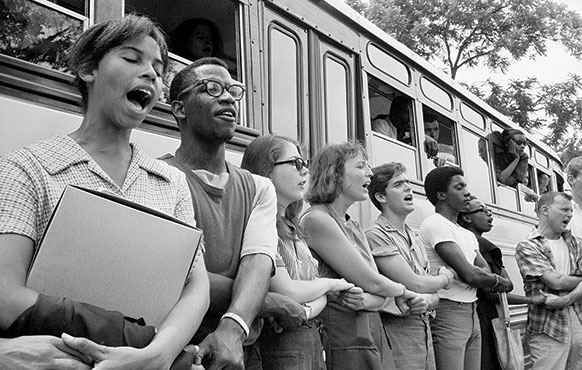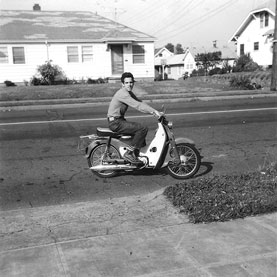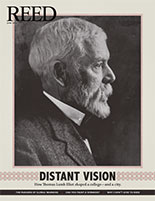
IRIS login | Reed College home Volume 93, No. 2: June 2014
Looking Back at Freedom Summer

Student civil rights activists singing as they prepare to leave Ohio to register black voters in Mississippi. The 1964 voter registration campaign was known as Freedom Summer. PRNewsFoto/Newseum, Ted Polumbaum
Fifty years on, Reedies reflect on the Summer of ’64
By Nisma Elias ’12

Bernard Wasow ’65 in fall 1963. “This photo reminds me of how empowered we felt in those days,” says Maryilyn Morgan Olmstead ’65, who registered voters in Watts. “We could do anything we wanted to set our minds to.”
Photo by Marilyn Morgan Olmstead ’65
It was a scorching August night, and there was tension in the air.
David Goodyear ’67 and two other civil-rights workers had stopped to buy cokes at a Texaco station in the little town of Laurel, Mississippi. They had traveled to this remote part of the state to register black voters for the Mississippi Freedom Summer Project, a movement that triggered a furious backlash from conservative whites. Days before, the dead bodies of three civil-rights workers had been discovered in Philadelphia, Mississippi, less than 100 miles to the north, beaten and shot by the Ku Klux Klan (KKK).
While they quenched their thirst, a car pulled up. Men got out brandishing clubs. The gas station locked its doors and turned out its lights, and Goodyear knew he and his friends were in trouble . . .
![]()
“If I get emotional, don’t be surprised” warned Bernard Wasow ’65 to the circle of Reedies gathered before him. “This is very personal for me.”
We were standing above the main lobby of the Newseum, a museum in Washington, D.C., which combines news history with state-of-the-art technology and interactive exhibits (it boasts the largest display of unaltered sections of the original Berlin Wall, including a three-story East German guard tower), and Bernard was about to lead us through a new exhibit titled “1964: Civil Rights at 50.”
1964 was a pivotal year for the long struggle for civil rights in the United States. Martin Luther King Jr. had electrified the nation with his “I Have a Dream” speech at the March on Washington the year before. The assassination of President John F. Kennedy had bequeathed new momentum to his Civil Rights Act, particularly in the Senate, where Southern Democrats had bottled up previous attempts for decades.
To demonstrate how the Jim Crow system prevented black Americans from voting, civil-rights leaders focused attention on Mississippi, where fewer than 7% of eligible black voters were registered to vote. Groups such as the Congress on Racial Equality (CORE) and the Student Non-Violent Coordinating Committee (SNCC) banded together as the Committee of Federated Organizations (COFO) and launched the Mississippi Freedom Summer Project. The idea was for civil-rights volunteers to go from door to door and encourage voters to register. The project involved black Mississippians and more than 1,000 volunteers from around the country—among them roughly a dozen Reedies.
![]()
After the last day of classes in May, 1964, Ray Raphael ’65 and Fred Winyard ’65 loaded up a station wagon full of donated clothing and supplies and headed south to the COFO office in Oxford, Mississippi. Raphael was already a committed civil-rights activist; he had spent his freshman summer in North Carolina with the National Students Association, assisting with voter registration, tutoring students in integrated schools, and working to desegregate public facilities such as swimming schools and baseball stadiums.
One of their first assignments was to take a load of supplies up to Ruleville, to deliver to a woman named Fannie Lou Hamer.
“Nobody knew who Fannie Lou Hamer was at this point, she was just a local activist,” explains Raphael. “At the very last minute they said there were two other people who needed a ride.” The other two turned out to be SNCC field secretaries Stokely Carmichael—who would become a prominent figure in the Black Power movement—and Charlie Cobb—who was instrumental in promoting the concept of Freedom Schools, which were set up to encourage political participation by teaching the history and philosophy of the civil rights movement, along with math, reading and other subjects.
“We head up with the car full of supplies, and I was driving,” Raphael says. “When on the way, all of a sudden, Charlie and Stokely hit the ground, down on the floor in the backseat and start swearing. ‘Why are they sending us these greenhorns, who don’t know what they’re doing?’”
In his naiveté, Raphael had committed a cardinal sin—he had stopped at a stoplight. For a car carrying both black and white passengers with a Northern license plate, stopping at a stoplight in a small town in Mississippi was an invitation to disaster.
After this dramatic incident, the Reedies drove up to Hamer’s house and were greeted by the matronly trailblazer herself—toting a gun.
Hamer was an inspirational figure in the civil-rights movement. A former cotton picker, she joined the struggle against Jim Crow and was arrested and beaten in jail. She refused to be intimidated, however. She become a key organizer of the Mississippi Freedom Democratic Party and made headlines for her powerful and eloquent testimony before the credentials committee of the Democratic National Convention of 1964.
“She said it was awesome we were down there doing this, and part of their struggle,” says Raphael. “She was the most amazing woman I had ever met in my life.”
Focusing the Spotlight
The rationale behind the Freedom Summer campaign was not simply to register voters, but also to focus the media spotlight on the issue of racial discrimination in the South. “We were going down there as Northern white volunteers, as privileged people basically, and knocking on the doors of black people who live there and asking them to make a dangerous move, which is to register to vote, and possibly face recrimination from local whites from doing so. Who are we to do that?” mused Raphael. “This is sensitive stuff—and stuff that I didn’t feel comfortable with, and I’m not comfortable with it now. But it was a part of the game—to nationalize the issue. We were kind of tools—our job was to get national attention.”
The work was anything but glamorous. Fred Winyard spent several weeks in a college basement in Holly Springs, unpacking donated books, sorting them, and reboxing them to start libraries. “I went with the first truckload, unpacked the first Freedom Library in Clarksdale,” he says. “The Sheriff told me of a new law in Mississippi which prohibited unlicensed libraries, but was obviously reluctant to enforce a law he thought was dumb.”
Tension was never far from the surface, however. Two libraries were destroyed by arson later that year. In June, three civil-rights workers—Michael Schwerner and Andrew Goodman, white students from New York, and a local African-American, James Chaney—disappeared near Philadelphia, Mississippi. Their torched station wagon was found a few days later.
Despite the sinister circumstances, many Americans refused to believe that the volunteers had been murdered. “I was struck how difficult it was to convince congressmen that they probably had met foul play,” said Wasow, who went to Washington, D.C., with other Freedom Summer volunteers to lobby Congress about civil rights. “Senator Paul Douglas of Illinois, for example, wanted to speak of nothing but the danger that Communists would control the summer project.”
The bodies of the three men were found on August 4, 1964, brutally beaten and shot by members of the KKK. Their murders drew national headlines and shook the movement to its core.

LATEST COMMENTS
steve-jobs-1976 I knew Steve Jobs when he was on the second floor of Quincy. (Fall...
Utnapishtim - 2 weeks ago
Prof. Mason Drukman [political science 1964–70] This is gold, pure gold. God bless, Prof. Drukman.
puredog - 1 month ago
virginia-davis-1965 Such a good friend & compatriot in the day of Satyricon...
czarchasm - 4 months ago
John Peara Baba 1990 John died of a broken heart from losing his mom and then his...
kodachrome - 7 months ago
Carol Sawyer 1962 Who wrote this obit? I'm writing something about Carol Sawyer...
MsLaurie Pepper - 8 months ago
William W. Wissman MAT 1969 ...and THREE sisters. Sabra, the oldest, Mary, the middle, and...
riclf - 10 months ago